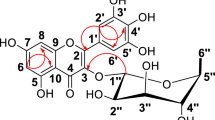Abstract
The growth inhibiting activity of materials derived from the stems of Ephedra pachyclada against intestinal bacteria was examined. Purification of the active constituent from E. pachyclada stems was conducted by silica gel chromatography and HPLC. The structure of the active component was identified as quinaldic acid (C10H7NO2, 173, quinoline-2-caboxylic acid) using various spectroscopic analyses including EI-MS, 1H-NMR, and 13C-NMR. The growth inhibiting activity varied according to the chemical, dose, and bacterial strain tested. Quinaldic acid showed a strong (+++) inhibition at 1.0 mg/disc against Clostridium difficile and Clostridium perfringens, and moderately inhibited the growth of C. Difficile and C. Perfringens at 0.5 and 0.1 mg/disc, respectively, but had no effect on the growth of Bifidobacterium bifidum, Lactobacillus acidophilus, and Lactobacillus casei. These results indicate that quinaldic acid should be considered as a possible antimicrobial agent for the treatment of diseases associated with intestinal bacteria.
Similar content being viewed by others
Abbreviations
- BHI:
-
brain heart infusion
- EI-MS:
-
electron impact mass spectrometry
- HPLC:
-
high performance liquid chromatography
- MRS:
-
deMan rogosa sharpe
- TLC:
-
thin layer chromatography
References
Aguilera MO, Stagnitta PV, Micalizzi B, and de Guzman AM (2005) Prevalence and characterization of Clostridium perfringens from spices in Argentina. Anaerobe 11, 327–334.
Al-Khaldi SF, Myers KM, Rasooly A, and Chizhikov V (2004) Genotyping of Clostridium perfringens toxins using multiple oligonucleotide microarray hybridization. Mol Cell Probe 18, 359–367.
Alterkruse SF, Cohen ML, and Swerdlow DL (1997) Emerging foodbone disease. Emerg Infect Dis 3, 285–293.
Caveney S, Charlet DA, Freitag H, Maier-Stolte M, and Starratt AN (2001) New observations on the secondary chemistry of world Ephedra (Ephedraceae). Am J Bot 88, 1199–1208.
Cho JH, Lee CH, and Lee HS (2005) Antimicrobial activity of quinoline derivatives isolated from Ruta chalepensis toward human intestinal bacteria. J Microbiol Biotechnol 15, 646–651.
Chung JK, Kim MJ, Kee HY, Choi MH, Seo JJ, Kim SH, Park JT, Kim MG, and Kim ES (2008) Prevalence of food poisoning bacteria on hand in various age groups. J Food Hyg Safety 23, 40–50.
Colbère-Garapin F, Martin-Latil S, Blondel B, Mousson L, Pelletier I, Autret A, François A, Niborski V, Grompone G, Catonnet G, and van de Moer A (2007) Prevention and treatment of enteric viral infections: possible benefits of probiotic bacteria. Microbes Infect 9, 1623–1631.
Demirci F, Guven K, Demirci B, Dadandi MY, and Baser KHC (2008) Antibacterial activity of two Phlomis essential oil against food pathogens. Food Control 19, 1159–1164.
FAO/WHO (2004) Joint FAO/WHO workshop on Enterobacter Sakazakii and other microorganisms in powdered infant formula, Geneva, Switzerland.
Gibbons S (2005) Plants as a source of bacteria resistance modulators and anti-infection agents. Phytochem Rev 4, 63–78.
Jeon JH, Lee CH, and Lee HS (2009) Antimicrobial activities of 2-methyl-8-hydroxyquinoline and its derivatives against human intestinal bacteria. J Korean Soc Appl Biol Chem 52, 202–205.
Kim JD (2002) The growth inhibiting effect of Enterobacteria, Clostridium perfringens KCTC 5014, by the combination of natural products. J Korean Soc Food Sci Nutr 31, 1119–1125.
Lee HS and Ahn YJ (1998) Growth inhibiting effects of Cinnamomum cassia bark-derived materials on human intestinal bacteria. J Agric Food Chem 46, 8–12.
Lim MY, Jeon JH, Jeong EY, Lee CH, and Lee HS (2007) Antimicrobial activity of 5-hydroxy-1,4-naphthoquinone isolated from Caesalpinia sappan toward intestinal bacteria. Food Chem 100, 1254–1258.
Musiol R, Tabak D, Niedbala H, Podeszwa B, Jampilek J, Kralova K, Dohnal J, Finster J, Mencel A, and Polanski J (2007) Investigating biological activity spectrum for novel quinoline analogues. Bioorg Med chem. 15, 1280–1288.
Nandhakumara R, Sureshb T, Calistus Judec AL, Rajesh kannand V, and Mohanb PS (2007) Synthesis, antimicrobial activities and cytogenetic studies of newer diazepino quinoline derivatives via Vilsmeier-Haack reaction. Eur J Med Chem 42, 1128–1136.
Nord CE, Rasmanis G, and Wahlund E (2006) Effect of dalbavancin on the normal intestinal microflora. J Antimicrob Chemother 58, 627–631
Park BS, Kim JR, Lee SE, Kim KS, Takeoka GR, Ahn YJ, and Kim JH (2005) Selective growth inhibiting effects of compounds identified in Tabebuia impetiginosa inner bark on human intestinal bacteria. J Agric Food Chem 53, 1152–1157.
Sahin A, Cakmak O, Demirtas I, Okten S, and Tutar A (2008) Efficient and selective synthesis of quinoline derivatives. Tetrahedron 64, 10068–10074.
Sibanda T and Okoh AI (2007) The challenges of overcoming antibiotic resistance: Plant extracts as potential sources of antimicrobial and resistance modifying agents. A J Biotechn 6, 2886–2896.
Songer JG (1996) Clostridial enteric diseases of domestic animals. Clin Microbiol Rev 9, 216–234.
Sorum H and Sunde M (2001) Resistance to antibiotices in the normal flora of animals. Vet Res 32, 227–241.
Starratt AN, and Caveney S (1996) Quinoline-2-carboxylic acid from Ephedra species. Phytochemistry 42, 1477–1478.
Tseng CH, Chen YL, Lu PJ, Yang CN, and Tzeng CC (2008) Synthesis and antiproliferative evaluation of certain indenol[1,2-c]quinoline derivatives. Bioor Med Chem 16, 3153–3162.
Author information
Authors and Affiliations
Corresponding author
Rights and permissions
About this article
Cite this article
Lee, CH., Lee, HS. Growth inhibiting activity of quinaldic acid isolated from Ephedra pachyclada against intestinal bacteria. J. Korean Soc. Appl. Biol. Chem. 52, 331–335 (2009). https://doi.org/10.3839/jksabc.2009.059
Received:
Accepted:
Issue Date:
DOI: https://doi.org/10.3839/jksabc.2009.059




